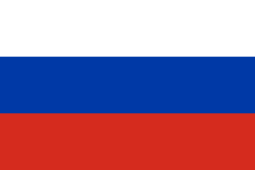Flag of Russia facts for kids
 |
|
| Name | Триколор Trikolor Tricolour |
|---|---|
| Use | National flag and civil ensign |
| Proportion | 2:3 |
| Adopted | 11 December 1993 (originally adopted on 28 April 1883, de facto used since 1668) |
| Design | Rectangular tricolour with three equal-size horizontal bands: the upper one is white, the middle blue, and the lower red. |
The flag of Russia is a special symbol for the country. It has three horizontal stripes: white at the top, blue in the middle, and red at the bottom. You might see these same colors on the flags of other Slavic countries, like Serbia, Slovenia, Croatia, Slovakia, and the Czech Republic.
History of the Russian Flag
Around the year 1699, Tsar Peter I traveled to the Netherlands. He wanted to learn more about building ships. During his trip, he realized that Russia needed its own flag for its navy.
The new Russian flag was designed to look like the flag of the Netherlands. That flag had three horizontal stripes: orange, white, and blue. Later, it changed to red, white, and blue.
Peter I chose colors that were important to Russia. He picked them from the coat of arms of the Principality of Moscow. This coat of arms showed a white knight on a white horse, wearing a blue coat and carrying a blue shield, all on a red background.
Later, people gave new meanings to the three colors. White stood for the "white Russians," blue for the "small Russians," and red for the "large Russians." These were names for different groups of people in the Russian Empire.
This flag was officially allowed to be used on May 7, 1883. But in 1917, a group called the Bolsheviks took power. They changed the national flag to a new design.
On August 22, 1991, the white, blue, and red flag was chosen again as Russia's national flag. There was a small change on December 11, 1993. The blue color on the flag became a bit darker.
The Andreyevsky Flag
Peter I also introduced another important flag for Russia. This was called the imperial flag of Russia. It has a blue X-shaped cross, known as a St. Andrew's cross, on a white background.
This flag was sometimes used along with the tricolor flag. Today, the Andreyevsky flag is still used as the official flag of the Russian navy.
On April 15, 1996, the Russian president Boris Yeltsin signed a document. It said that the victory flag was just as important as the Russian flag.
The victory flag is a special version of a flag from May 1, 1945. It looks similar to the flag of the Soviet Union. However, its star is a bit bigger, and it does not have the hammer and sickle symbols.
Images for kids
-
Russian flag during WWI on a postcard (1914–1917)
-
Patch of the First Russian National Army, one of the German-collaborationist militias which fought the Red Army during World War II
-
President Boris Yeltsin waving the flag during the August Coup, 1991
See also
 In Spanish: Bandera de Rusia para niños
In Spanish: Bandera de Rusia para niños









